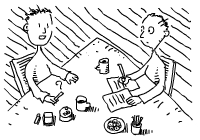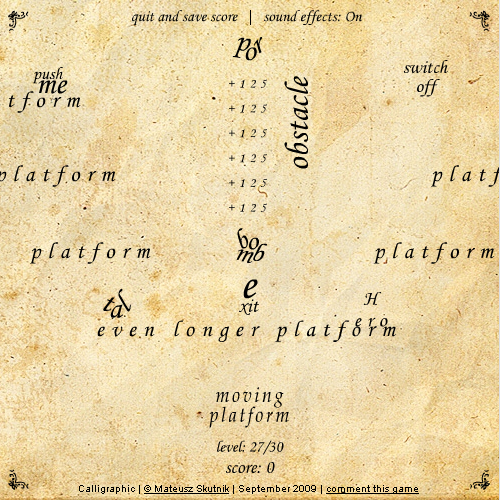Submachine 6; polska solucja
September 26, 2009
Po obejrzeniu intro na ekranie maluje nam się wnętrze pojazdu, w którym zakończyliśmy piątą część gry.
Otwieramy drzwi klikając mały przełącznik umiejscowiony na lewo od fotela, po czym idziemy L. Za te działania znagrodzeni zostaniemy druga częścią intro. ;-)
Gdy nasz pojazd osiągnie cel, wychodzimy z niego P i umieszczamy wszystkie przedmioty z ekwipunku w okrągłym, widocznym na środku ekranu pojemniku (inaczej skaner w kolejnym pokoju nas nie przepuści).
Przechodzimy pokój dalej i klikamy czerwony przycisk.
Skaner zrobi to, co do niego należy, wskutek czego drzwi po prawej otworzą się. Przechodzimy przez nie, klikamy ekran, a następnie kilka losowych cyfr – system prosi nas o kod identyfikacyjny, ktorego i tak nie znamy.
Rezultatem zabawy z cyframi będzie komunikat błędu i lądowanie w mało przyjaznej lokacji…
Idziemy L L, po czym klikamy na widocznym występie skalnym.
L L L umieszczone jest zakratowane przejście – otwieramy je kliknięciem, kolejnym kliknięciem wchodzimy.
Idziemy P G L i jednym kliknięciem przekręcamy widoczny “zawór”.
Następnie P P, klikamy dziwną konstrukcję z łbem gargulca (?) – przesunie się w prawo.
L G, podnosimy key card i wracamy D L.
Klikamy na zaworze dwa lub trzy razy, co umożliwi nam powrót.
Idziemy P D P i wchodzimy do widocznego w ścianie otworu.
Jeden ekran na prawo mamy dwie drogi – wybieramy pierwszą od góry, z prawej. Wyszliśmy z tej znajdującej się poniżej.
Idziemy G L – czeka nas zabawa z zaworami. Chodzi o to, by podświetlone punkty na obu zaworach ustawiły się w tej samej pozycji kątowej – 0 stopni, 180 stopni czy 270 stopni (jeśli za 0 przyjmiemy zegarową pozycję godziny trzeciej).
Klikamy zawór lewy, potem prawy. Oba podświetlone elementy ustawiają się w pozycji 180 stopni.
P G czeka nas pomieszczenie z drabiną – teraz będzie ona ustawiona całkowicie z lewej.
Na suficie mamy trzy rury – wchodzimy w lewą i naciskamy przycisk.
Wracamy do pomieszczenia z zaworami.
Przekręcamy znów zawoty w kolejności lewy-prawy-lewy-prawy i idziemy do pokoju z drabiną – tym razem wchodzimy do prawej rury, nasickamy przycisk i ponownie wracamy do zaworów.
Kombnacją lewy-prawy umieszczamy je w pozycji 270 stopni, po czym opiszczamy ostatecznie pokój i udajemy się P G do pokoju z drabiną – wchodzimy w środkową rurę, a potem G.
Idziemy P, wkładamy key card do czytnika i naciskamy przycisk – powinna pojawić się winda. Wchodzimy do niej i wybieramy pierwszy od góry przycisk.
L znajduje się komputer zarządzający poziomem bezpieczeństwa. Klikamy ekran, a następnie kliknięcimi umieszczamy trzy przełaczniki w pozycji dolnej (z prawej powinno pojawić się 0).
Wracamy do windy i wybieramy środkowy przycisk.
Idziemy L L L, zabieramy kostkę.
Wracamy do windy, naciskamy przycisk znajdujący się na samym dole.
Idziemy L L i wchodzimy do widocznej na srodku ekranu rury. Następnie: D D D P G G, przekręcamy zawór, idziemy D D, a następnie wybieramy drugi od góry, po prawej właz.
Klikamy dwie rączki, co spowoduje zwolnienie zasuwy.
Wracamy L i wchodzimy do rury pierwszej od góry, po prawej.
P P P, umieszczamy kostkę na kolumnie, wracamy L i przekręcamy kamienne koło z klepsydrą.
Idziemy znowu P, wyjmujemy z kostki dziwny przedmiot – upadnie na podłogę i rozbije się.
Nie przejmujemy się tym – idziemy L, ponownie przekręcamy koło z klepsydrą i w pokoju obok znajdujemy całe urządzenie, jak i znowu nienaruszoną kostkę.
Podnosimy urządzenie (connection pod) i wracamy L L L L G G, przekręcamy zawór, D, D, wchodzimy do pierwszej od góry, z lewej rury, G G G G P P.
Wybieramy górny przycisk i idziemy do końca w lewo.
Wkłądamy connection pod do gniazda w ścianie.
“Idziemy” do góry, przełączamy przełącznik.
Wracamy D i klikamy na symbolu connection pod, co pozwoli nam “wyjść” z systemu.
Wyjmujemy connection pod z gniazda (musimy to robić po każdym odłączeniu się!), wracamy do windy i udajemy się do środkowej kondygnacji.
L są otwarte drzwi 5 – wchodzimy, wpinamy się w gniazdo, potem D, przełączamy przełącznik i opuszczamy system, nie zapominając o zabraniu ze sobą connection pod.
Windą udajemy się na górną kondygnację, L L, wchodzimy przez drzwi 8. Następnie P P P P, wpinamy się do systemu, L i dezaktywujemy kliknięciem przełącznik odpowiedzialny za gate 3/18.
Opuszczamy system, idziemy L L, wpinamy się ponownie. Idziemy P P i przełączamy wszystkie przełączniki, a następnie wychodzimy z systemu.
Idziemy znów P P, podpinamy się, potem G i kikamy dwukrotnie zielony kwadrat z literką ‘e’ – ma się znaleźć z prawej, obok kwadratu z wpisanym kołem i doprowadzoną linią.
Opuszczamy system i udajemy się do innej windy, ktora pojawiła się z prawej.
Wybieramy środkowy przycisk, idziemy L G, podłączamy się do gniazda widocznego z lewej. L, przestawiamy przełącznik na “disarmed”, następnie P D przełączamy taki sam switch na “offline”.
Opuszczamy system, idziemy D L G, podłączamy się do gniazda z prawej. G L znajdujemy kolejny przełącznik, przełączamy go – jednakże następnie wybieramy “cancel” i potwierdzamy, co wywoła błąd systemu.
Wracamy z powrotem do beżowej windy i wybieramy przycisk z prawej. Idziemy L G G i podłączamy się do głównego systemu obronnego.
Klikamy “przycisk” umiejscowiony na środku ekranu, pod napisem “mainframe”. Oglądamy animację.
Udajemy się w lewo, gdzie czeka nas zagadka. Poruszanie myszą w pionie powoduje obrót lewego ramienia i przesuwanie się prawego, zaś w poziomie – obrót prawego i poruszanie się lewego. Naszym zadaniem jest takie manewrowanie myszą, by końce obu ramion zetknęły się.
Gdy nam się to uda, wracamy P i przełączamy środkowy przełącznik do pozycji prawej (dwa kliknięcia).
Idziemy P G, aktywujemy gate 115, następnie D P i przełączamy przełącznik.
Wracamy L L, ustawiamy obrotowy przełącznik w pozycji górnej.
Idziemy G G i klikamy przycisk widoczny na środku ekranu.
Udajemy się do protocol 1-32, przełączamy przełącznik i wracamy.
Następnie w protocol 1-28 czeka nas zagadka, w której musimy tak obracać poszczególne segmenty “ramienia”, by polączyć je z okręgiem widocznym u dołu.
Gdy to zrobimy, wracamy do “gwiazdy” i wybieramy protocol 1-35. W tym przypadku ciągnięcie myszy w prawo bedzie wysuwało pierwsze, poziome ramię, a poruszanie myszą w górę – obracało drugie. Ponownie musimy doprowadzić do zetknięcia się końców obu.
Po wykonaniu zadania wracamy i wybieramy protocol 1-12, idziemy P, wybieramy “reset” i potwierdzamy.
Wyłączyliśmy systemy obronne! Wracamy i na ekranie z “gwiazdą” wybieramy protocol 1-0.
Idziemy G, zmieniamy pozycję przełącznika i potwierdzamy. Dowiadujemy się, że to koniec naszej podróży i zostajemy odłączeni.
Idziemy D D, podnosimy connection pod i udajemy się L.
Klikamy dwukrotnie na niedziałającym wentylatorze, a trzecim kliknięciem wchodzimy do rury.
Idziemy G G G G, klikamy wylot rury, następnie P P. Wkładamy connection pod do portalu i zmieniamy pozycję przełącznika, który ukazał się na ekranie.
Gratulacje! Udało Ci się ukończyć grę. Ale jest jeszcze 5 sekretów do znalezienia… ;-)
autor: Tavaro.








 Online gaming is going through a renaissance, with hundreds of websites offering free games to while away the time. One company making waves in the sector is Pastel Games – a Polish game developer responsible for such hits as the Submachine series and the Squirrel Family games. WBJ.pl speaks with company founders Mateusz Skutnik and Karol Konwerski about their their business model, the state of the industry and developing for the iPhone.
Online gaming is going through a renaissance, with hundreds of websites offering free games to while away the time. One company making waves in the sector is Pastel Games – a Polish game developer responsible for such hits as the Submachine series and the Squirrel Family games. WBJ.pl speaks with company founders Mateusz Skutnik and Karol Konwerski about their their business model, the state of the industry and developing for the iPhone.